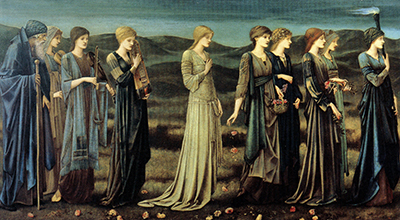The Wedding of Psyche piece by Edward Burne-Jones displays a striking foil look to the well-known Mirror of Venus, which was of twenty years before. They both delineate ladies in a desolate scene: a female focal figure, of a standard magnificence, and their orderlies.
This work of art demonstrates a piece of the legendary story comprising of the primary characters Cupid and the famous Psyche. It delineates the location of Psyche's wedding in which Psyche is left on a mountain where she was to be handed over to a beast that stayed on the highest point of the hill. However, the state of mind and the psychology of the people in The Wedding of Psyche piece demonstrates an extreme Burne-Jones' style even after twenty years in between the two pieces. It is specific striking because of the fanciful connection between the two focal figures: Venus, envious of Psyche's magnificence, sentenced her to wed the ugliest creature in the land.
Christopher Wood depicts The Mirror of Venus as "simply aesthetic". "The picture could similarly have been titled after a dubious figurative title," he said that nothing grounds the image in a specific story. This piece delineates a fanciful occasion and a miserable one for that matter. The figures in the Mirror piece are engaged in their appearance, getting away from the outside world because of their narcissism. They walk from one side to the next in dreary single-style. As opposed to being lost in their very own appearance, the individuals from the Wedding gathering appear to be lost in thoughts. The people are either looking forward or, on account of Psyche, on the fruitless floor. Along these lines, the infertility of the scene in the Mirror piece appears to propose the general harshness of the world contrasted and the excellence of the focal figures. In the Wedding piece, the blue tones of the sloping scenes point to a distressing future for Psyche.
Even though the figures in the Wedding art are walking forward, they don't demonstrate any of the traditional contrapposto that the artist Burne-Jones loved to use in his prior pieces. He decreases their general drapery to medieval seriousness, the characters are inflexible and flat, practically gender-ambiguous, in their physical appearance. In the piece Mirror of Venus, Burne-Jones delineates Venus with a Botticellian exotic nature; her figure is noticeable under her streaming drapery.




